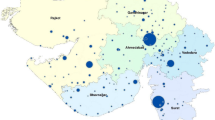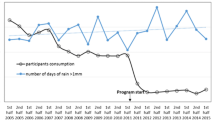Conclusion
Although substantial financial commitments are being made by government towards improving the backlog in urban water provision there are a number of policy concerns which may hamper the full realisation of the goal of adequate. water supply for all. Research findings suggest that current infrastructure levels may be too low to ensure consumption levels sufficient for the protection of public health. Further consideration of the relationship between minimum service levels and consumption levels should be undertaken to ensure that enough water is being used by those with access to only the minimum level of water infrastructure.
In addition, financial policy for urban water supply has yet to find a conclusive balance between local revenue generation and cost recovery on the one hand, and central and local government subsidisation on the other. A smoother co-ordination of broad municipal investment and financing policy with water supply and pricing policy will help to ensure that a consistent and clear approach to both the financing of urban water supply and to the expected payments by poor households is generated. Until there is policy co-ordination at this level, significant discretion will remain with local government which will not in all cases have the financial resources—or the political will—to act in the interests of the poorest and most poorly served residents.
Similar content being viewed by others
References
Bahl, R., and Linn, J. 1992.Urban Public Finance in Developing Countries. Oxford University Press.
Cairncross, S. 1990. Water Supply and the Urban Poor. In Cairncross, S., Hardoy, J. and Satterthwaite, D. (eds),The Poor Die Young: Housing and Health in Third World Cities. London: Earthscan, pp.109–26.
Central Statistical Services. 1996.October Household Survey 1995. Statistical Release PO317. Pretoria.
Central Statistical Services. 1997a.October Household Survey 1995—Gauteng. Statistical Release PO317.7. Pretoria.
Central Statistical Services. 1997b.Census '96—Preliminary Estimates of the Size of the Population of South Africa. Pretoria.
Coetzee, H. 1991.Taps and Toilets: A Study of Water Supply in South Africa, with a Focus on Informal Settlements on the Witwatersrand. Johannesburg: Group for Environmental Monitoring.
Cranshaw, O. and White, C. 1991. Unpublished Report prepared for Johannesburg City Council based on a Household Survey of Powa Park. Johannesburg: Human Sciences Research Council.
Department of Constitutional Development 1996. Municipal Infrastructure Investment Framework. Draft Document. Pretoria.
Department of Finance. 1996.Growth, Employment and Redistribution: A Macroeconomic Strategy. Pretoria: Government Printer.
Department of Water Affairs and Forestry 1994.Water Supply and Sanitation Policy. White Paper: Water—An Indivisible National Asset. Cape Town.
—. 1997a.White Paper on a National Water Policy for South Africa. Pretoria: DWAF.
— 1997b.Draft National Water Supply Regulations, Part I: Regulations Governing the Activities of the Local Authority. Pretoria: DWAF.
Eberhard, R. and Quick, A. 1995. Water supply and sanitation in urban South Africa: Getting it right during the transition and beyond.Development Southern Africa 12(6):883–906.
Fair, D. 1995. Water and sanitation in Sub-Saharan Africa: Serving the rural poor.Africa Insight 25(1):48–53.
Fass, S. 1993. Water and poverty: Implications for water planning.Water Resources Research 29(7):1975–81.
Goldblatt, M. 1997. The Provision, Pricing and Procurement of Water: A Survey of Willingness to Pay in Two Informal Settlements in Greater Johannesburg. MSc. dissertation, University of the Witwatersrand, Johannesburg.
Hardoy, J. and Satterthwaite, D. 1989. Environmental Problems in Third World Cities: A Global Issue Ignored? Paper presented at the conference, Cities —the Mainspring of Economic Development in Developing Countries, Lille, France.
Hollingworth, B. 1994. Water Supply: Service Levels and Performance Standards. Paper presented at the National Water Supply and Sanitation Policy Conference, World Trade Centre, Kempton Park.
Jordan, S. and Wagner, F. 1993. Meeting women's needs and priorities for water and sanitation in cities.Environment and Urbanization 5(2):135–45.
Kjellen, M., Bratt, A. and McGranahan, G. 1996.Water Supply and Sanitation in Low and Middle Income Cities: Comparing Accra, Jakarta, and Sao Paulo. Stockholm Environment Institute, Report No. 1, Urban Environment Series. Stockholm: SEI.
Palmer Development Group 1993.Evaluation of Water Supply to Developing Urban Communities in South Africa, Phase 1—Overview. Prepared in association with the University of Cape Town for the Water Research Commission, Pretoria.
Palmer Development Group 1994a.Water and Sanitation in Urban Areas: Financial and Institutional Review. Report 2: Overview of the Demand for and Costs of Water Supply and Sanitation Services in South Africa. WRC Report No. 571/2/94, prepared for the Water Research Commission, Pretoria.
Palmer Development Group 1994b.Water and Sanitation in Urban Areas: Financial and Institutional Review, Report 1: Overview of Institutional and Financial Arrangement in Water Supply and Sanitation. WRC Report No. 571/1/94, prepared for the Water Research Commission, Pretoria.
Palmer Development Group 1994c.Water and Sanitation in Urban Areas: Financial and Institutional Review, Report 6: Summary Report. WRC Report No. 571/6/94, prepared for the Water Research Commission, Pretoria.
Republic of South Africa. 1996.Constitution of the Republic of South Africa. Cape Town: Constitutional Assembly.
Stephenson, D. 1995. Factors affecting the cost of water supply to Gauteng.Water SA 21(4):275–80.
Triebel, C. 1994. Tariffs for Water Supply and Sanitation. Paper presented at the National Water Supply and Sanitation Policy Conference, World Trade Centre, Kempton Park.
Van Reyneveld, M. 1995. Costs and affordability of water supply and sanitation provision in the urban areas of South Africa.Water SA 21(1):1–14.
Rights and permissions
About this article
Cite this article
Goldblatt, M. Realising the right to sufficient water in South Africa's Cities. Urban Forum 8, 255–276 (1997). https://doi.org/10.1007/BF03036772
Issue Date:
DOI: https://doi.org/10.1007/BF03036772




